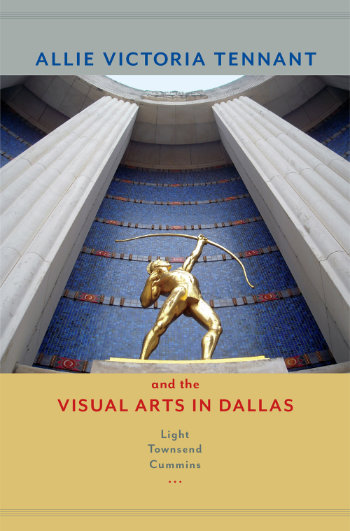
Allie Victoria Tennant and the Visual Arts in Dallas, by Light Townsend Cummins, 2015
This book was the first in the Women in Texas History series. Winner, 2016 Liz Carpenter Award for Research in the History of Women, presented at the Texas State Historical Association Annual Meeting.
At Fair Park in Dallas, a sculpture of a Native American figure, bronze with gilded gold leaf, strains a bow before sending an arrow into flight. Tejas Warrior has welcomed thousands of visitors since the Texas Centennial Exposition opened in the 1930s. The iconic piece is instantly recognizable, yet few people know about its creator: Allie Victoria Tennant, one of a notable group of Texas artists who actively advanced regionalist art in the decades before World War II.
Light Townsend Cummins follows Tennant’s public career from the 1920s to the 1960s, both as an artist and as a culture-bearer, as she advanced cultural endeavors, including the arts. A true pathfinder, she helped to create and nurture art institutions that still exist today, most especially the Dallas Museum of Art, on whose board of trustees she sat for almost thirty years. Tennant also worked on behalf of other civic institutions, including the public schools, art academies, and the State Fair of Texas, where she helped create the Women’s Building. Allie Victoria Tennant and the Visual Arts in Dallas sheds new light on an often overlooked artist.

LIGHT TOWNSEND CUMMINS is the Guy M. Bryan Jr. Professor of American History at Austin College in Sherman, Texas. He is the author or editor of a dozen books, including Emily Austin of Texas, 1795–1851. From 2009 to 2012, he served as the State Historian of Texas.
What Readers Are Saying:
“Light Cummins’s superb biography of Allie Victoria Tennant is a history of the artist best known as the sculptor of the majestic Tejas Warrior. But she was much more than simply a practicing artist. She was an organizer, leader, and insider in organizations and institutions related to art and culture in Dallas. Faced with an almost complete absence of her personal papers or writings, Cummins exemplifies the best example of a historian as detective.”
—Mary L. Scheer, author of Women and the Texas Revolution
"Dr. Cummins's book explores the development of Allie Victoria Tennant as an artist and sculptor in the context of the evolving art scene in Dallas and Texas, providing much new information about both. A special focus of this exploration, with a substantial amount of new information, is the role of women as artists and their role in and contributions to the emerging Dallas and Texas art scenes. This book is a must read for anyone interested in Texas art."—D. Jack Davis, professor emeritus and former dean of the College of Visual Arts and Design, University of North Texas
“This work is important as a biography of an American artist who lived in Dallas and one who well deserves critical attention. Cummins rightly assessed the significance of Tennant's art. Cummins gathered the art historical evidence to place Tennant's sculpture as significant within the history of local, regional and national perspectives. The work is also an important study of the Dallas Art scene over seven decades, placing Tennant's art and aesthetic firmly as a Texas Regionalist and distinguishing her among her peers including E. G. Eisenlohr, Jerry Bywaters, and other important artists and culture bearers. Cummins provides the best explanation of the definition of the "Dallas Nine," eclipsing several other able authors who have attempted to clarify the origin and use of the term. This work clearly articulates how Tennant related early on to Regionalism and the American Scene and how, over her lifetime, her art and attitudes conformed to the prevailing values in American culture."—Francine Carraro, director of Wichita Falls Museum of Art
"Allie Victoria Tennant and the Visual Arts in Dallas is a compelling exploration of how one remarkable artist, with great purpose and quiet assurance, helped her communities—both locally and statewide—develop a distinct and enduring sense of place.” —East Texas Historical Journal